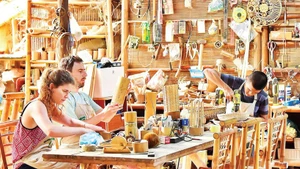Thua Thien Hue has 92 craft villages, including 42 traditional craft villages with longstanding historical heritage, including: Phuong Duc bronze casting, Phu Cam conical hats, Bao La bamboo weaving, Dia Linh mother-of-pearl inlay, My Xuyen sculpture, Ke Mon jewellery making, Phuoc Tich pottery, Sinh Village paper paintings, Thanh Tien paper flowers, and A Luoi weaving. These craft villages are considered treasure troves of craft knowledge and rich cultural heritage with which to develop local craft village tourism.
Preserving and maintaining craft villages
Among Hue’s designated craft villages, over 20 traditional craft villages remain active today, including bronze casting, jewellery making, incense making, pottery, paper flowers, wood carving and weaving. Their products are popular with domestic and international tourists alike, as many businesses and craft villages have implemented innovative approaches to increase the income of locals while preserving and developing traditional crafts. Many Hue natives, whether living far from home or overseas, still fondly remember the distinctive craft products of their homeland.
After receiving the “Most Attractive Destination in Vietnam” award from the Vietnam Tourism Association in 2015, Thanh Tien Paper Flower Village in Phu Mau Commune, Phu Vang District (now part of Hue City), has become even more well-known, attracting both domestic and international tourists.
Artisan Nguyen Hoa from Thanh Tien Village, Phu Mau Commune, shared that he welcomes hundreds of international and domestic tourists and student groups weekly. Currently, at its busiest, Thanh Tien Paper Flower Village has around 30 households making flowers, with visitors admiring the artisans’ talent and skilfulness. For tourists, these traditional craft villages hold a special appeal because each craft village is connected to a system of historical and cultural relics.
According to Hue City’s Department of Culture, many craft villages have evolved from simply producing consumer goods and interior/exterior decorations to developing impressive craft village tours. Thuy Xuan incense village is a prime example of this transformation, having changed from a village that previously only made products for daily life into a famous tourist destination.
Almost every tourist who visits Hue makes a stop at Thuy Xuan Incense Village for photo opportunities. The combination with traditional five-panel ao dai has turned the incense village into a new tourism phenomenon in the former imperial capital over the past two years. Many tourists also buy agarwood incense products here as gifts for family and friends. Residents’ income has increased significantly since this shift in focus.
According to the Thua Thien Hue Department of Tourism, preserving, maintaining, and developing traditional crafts has brought both material and spiritual value to locals and tourists. Notably, craft villages have helped people establish their brand identity and created employment opportunities for many workers. In addition to contributing towards increased income for residents, these craft villages also serve as places that preserve and connect with regional cultural values.
For example, jewellery making is one of Hue’s famous traditional crafts with a long history. This craft originated from Ke Mon Village in Dien Mon Commune (Phong Dien District), located about 40 kilometres northeast from the centre of Hue City.
Artisan Tran Duy Mong shared: “For many years, Hue’s jewellery-making craft has been passed down from generation to generation, both preserving and developing the trade, continuing to create products with distinctive features and high artistic value. Each period has had dedicated artisans and skilled craftspeople who wholeheartedly maintain and pass on the craft to younger generations.”
In other craft villages, specialising in weaving, painting, bronze casting, and artistic woodworking, skilled artisans and craftspeople create artistic works such as furniture, statues, paintings, and decorative items for homes, gardens, tourist areas, hotels, and restaurants. Although made from traditional rattan and bamboo materials, woven products have now been stylised and modernised into unique decorative interior items like furniture and lanterns, which are often ordered by restaurant and hotel owners.
Much potential needs to be explored
At Phuoc Tich Pottery Village in Phong Hoa Commune (Phong Dien District), a group of representatives from travel agencies nationwide are captivated by the peaceful village scenery and fascinated by Phuoc Tich’s pottery craft. A representative from a Ho Chi Minh City travel agency shared: “Being guided and making pottery by hand is very interesting. The experiences here feel like taking everyone back to their childhood, returning to natural, rustic beauty. This material can be developed for tourism.”
Not just in Phuoc Tich, Hue has many crafts and craft villages that can be developed for tourism. Director of the Department of Tourism Nguyen Van Phuc notes that Hue was an economic, political, and cultural centre for over 400 years and was the capital of the Tay Son and Nguyen dynasties for nearly 160 years, preserving and spreading beauties that span time.
Hue is also a land that gathered creative talents from across the country, containing a special cultural treasure trove of natural landscapes, history, architecture and unique traditional craft villages. Currently, the province has recognised 7 traditional crafts, 10 craft villages and 20 traditional craft villages across 8 out of its 9 districts, towns and cities.
In recent years, with guidance from provincial and local leadership, the province’s crafts and craft villages have been revived and gradually adapted to market mechanisms. These include: Van Cu and O Sa noodle making, Phu Thuan fish sauce, My Xuyen woodworking, and others. Hue has also developed additional crafts such as artistic woodworking, embroidery and lace, and bamboo weaving, helping to tap into local potential and strengths while increasing industrial and handicraft production value.
Phuc stated that many craft villages are now oriented towards tourism development, showing promising initial results. However, alongside positive aspects, craft and craft village development still faces many limitations such as lack of planning, lack of brand building, lack of development strategies, and small-scale operations, along with somewhat outdated technical infrastructure, use of mostly traditional manual tools, products mainly for self-sufficiency, low competitiveness, environmental pollution, and many traditional crafts operating at minimum capacity with risk of decline and disappearance.
Over the years, the province has implemented policies to preserve and develop craft villages. Thua Thien Hue Vice Chairman Nguyen Thanh Binh stated that the province is implementing the project on developing craft and craft village tourism for the 2022-2030 period, aiming to preserve and promote cultural heritage values and history while advancing the socio-economic values of traditional craft villages.
Developing craft village tourism not only preserves traditional cultural quintessence but also creates employment, improves local income, while driving socio-economic development and strengthening craft village integration.
According to tourism department leadership, developing craft and craft village tourism requires not only efforts of the tourism sector but also cooperation from many sectors, localities, businesses and residents.
The tourism sector and localities need to focus on multiple solutions, including developing traditional craft and craft village tourism sites and routes; researching and developing tourism types and products; regularly conducting tourism market research to build strategies, programmes and plans for promoting destinations, products and traditional craft village tourism brands; diversifying promotional forms for traditional craft village tourism; and creating 3D digital versions of typical traditional craft village tourism development sites to serve promotion and provide more visual introduction of traditional craft village products and services to domestic and international tourists.
















